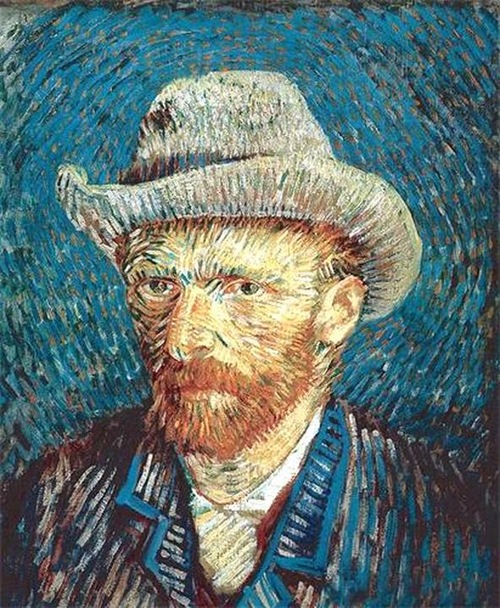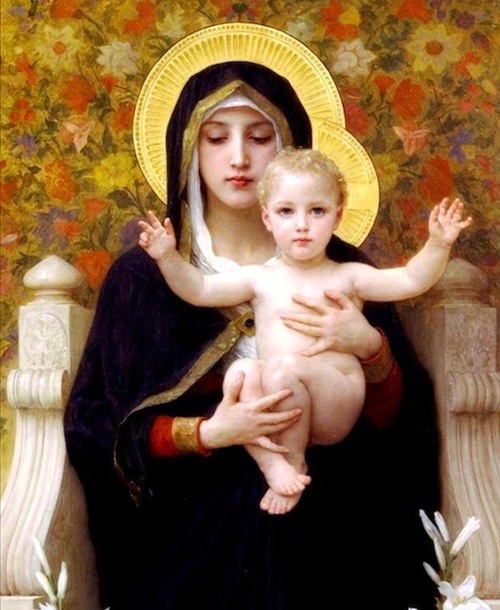(Minghui.org) I used to paint in the past, but after I was persecuted by the Chinese communist regime for practicing Falun Dafa, there was a period of time when I lost my memory and couldn't recall how to paint, much less know how to pick up a paintbrush.
Later, when my painting teacher looked for me to paint again, he helped me find my feeling for painting and my sensitivity to colors by using a technique called “pointillism.” This is where colors are directly applied on canvas, where the colors will mix optically, instead of mixing the colors on the palette.
As a result, patches of colors will be formed, and obvious brushstrokes will be seen clearly. As time passed, it became a habit of mine that was difficult to change.
(Note: I am not criticizing my teacher here but am trying to explain that this method was used due to special circumstances, and it was because of this training that I again found my keen observation towards colors. I am thankful to my teacher for this!)
In recent years, I have been searching for a way to improve my technique so as to get rid of the immature techniques from my student life. However, it was recently when I finally enlightened that my notions had been obstructing myself from improving my technique.
While reflecting on my own journey of learning how to paint, and after visiting the Leonardo da Vinci castle on the 500th anniversary of his death, and looking at William-Adolphe Bouguereau's personal painting journey, I suddenly had a realization that the technique regarding brushstrokes in painting can be quite a profound topic.
Hence, I would like to share my understanding below:
Emphasizing Brushstroke is Expressing Personality
I have met some Modernists who emphasized the attractiveness of the brushstroke and personality, making it seem like this is something very important to focus on. There was a period of time when I was influenced by them.
However, after reading Master Li Hongzhi's article, “For Whom do You Exist?” in Essentials For Further Advancement and combining my long-term knowledge and personal observations, I suddenly realized: Using excessive brushstrokes to be “expressive” is in fact expressing my personality and postnatal notions.
A person's unusual personality can be seen from an excessive brushstroke, just like Vincent Willem van Gogh, who cut off his ear after suffering from a psychotic episode.
A person who expresses his or her personality excessively can make others feel that he or she is not easygoing, stubborn, and arrogant. This is exactly what people in the arts pursue, but is this really good?
 Self-portrait of Vincent Willem van Gogh, 1853-1890, Netherlands
Self-portrait of Vincent Willem van Gogh, 1853-1890, Netherlands
When walking along the streets of some big cities that are filled with art galleries or visiting Modernists art exhibitions, I saw that Modernist themes usually focus on portraying the world of ghosts, the artist's subconscious thoughts, and even lust.
One might also not be able to tell what exactly the painting is about, and it would be up to the viewer to understand it based on their feelings. Looking at these paintings can stimulate the frustrated emotions of the viewer, and those who are sensitive may feel very uncomfortable.
From 1949 onward, mainland Chinese students have been taught how to paint based on the foundation of painting from the former Soviet Union. Due to the environment at that time, we thought that the best painters in the world were from Russia and thus idolized Ilya Repin and other Soviet painters.
We imitated their paintings in large quantities and also collected Russian paintings. As time passed, I left China and came into contact with European paintings.
As I observed and studied the paintings from the Renaissance, and with the broadening of my knowledge, I realized that I would not again easily say which painters I admired or be driven by the surface of the painting. Instead, I now analyze everything rationally.
Studying Master's lecture on the fine arts and diligently looking for an answer, I realized in these two years that the techniques used by Repin and other painters are actually a strong expression of their personality. Moreover, Repin lived in a time period in which things were used by politics, which is why the communist regime praised the Soviet Union's painting techniques.
As I write this, I recalled this phrase: “What the regime persecuted is good and what the regime praised was used to serve them.”
The painting techniques of the Soviet Union were deeply rooted in every art student's mind. After the Chinese economic reform, Western Impressionism, Fauvism, and Modernism influenced mainland China, and everyone started to pursue the liberation of personality.
Thus, having strong brushstrokes became a good catharsis for expressing personality. It was after I left China that I was able to calmly look back and also have the opportunity to look at the original works of the Renaissance, such as those by Italian and French painters: Leonardo Da Vinci, Raphael, Johannes Vermeer, William-Adolphe Bouguereau.
After looking at a large amount of the original works, and with a deeper understanding of the Buddha Fa, I recently realized that from a painter’s brushstroke, one could see his realm of cultivation, his personality, whether he is rational, his motives, and his attitude.
It was then that I found the answer—I had been obstructed by “postnatal notions.” I had the bad habit of deliberately pursuing brushstrokes until I was tired of it.
I realized that I needed to have an understanding about brushstrokes—a movement that is so small—as that is every step that makes up the entire painting.
I previously read a long article that criticized Russian paintings and developed a headache after reading due to the words used, which could evoke a person's thought karma. It made me realize that writing an article is just like the brushstroke in a painting, which expresses one's personality.
Those words that stimulate a person's negative side are actually like the glaring colors or similar brushstrokes in a painting. If the purpose of an article is to teach someone a lesson and to express oneself, even if the article is criticizing communism, it is still tainted by the evil aspect of communism.
Such articles can make people feel uncomfortable. Those Modernists paintings that express one's own personality have the same effect—they spread the painter's karma to others and harm the viewers' health.
In actuality, when one is rational and explains things kindly, many readers would respect and accept the article. Thus, if we do not pay attention to our speech, words, and paintings, we would be expressing our own personality, and as a cultivator, these can become a weapon that harms others.
I am fortunate to be cultivating Dafa. If I were an everyday person, I would be painting or writing an article while driven by attachments of my postnatal notions.
Thus, we need to reflect more on ourselves and see if we have the problem of expressing ourselves. The original nature will gradually emerge only when a person lets go of postnatal notions and self.
One will have divine things after letting go of the human side. This is what I have benefited from while cultivating.
Artworks By the Old Masters
The paintings by Renaissance painters, Leonardo Da Vinci, Raphael, Michelangelo, and also William-Adolphe Bouguereau, are exquisite. I remember reading the learning journey of Bouguereau and how he once tried to restrain expressing his own brushstroke and worked hard to learn the traditional painting techniques and adhere to them even though his era already had the academy, which had conflicting views.
Bouguereau did not follow social trends; instead, with a lot of delicate paintings, he painted the world of God that could not be depicted by photography. He used outstanding painting to prove that photography would not be able to replace traditional painting.
 Lady with an Ermine (Dama con l'ermellino), a painting by Italian artist Leonardo da Vinci from around 1489–1490. It is currently at Czartoryski Museum in Kraków, Poland.
Lady with an Ermine (Dama con l'ermellino), a painting by Italian artist Leonardo da Vinci from around 1489–1490. It is currently at Czartoryski Museum in Kraków, Poland.
 La Vierge aux Lys, painted in 1899 by French artist William-Adolphe Bouguereau (1825-1905), one of the most important figures in French art painting in the French Academy from the first half of the 19th century to the end of the 19th century.
La Vierge aux Lys, painted in 1899 by French artist William-Adolphe Bouguereau (1825-1905), one of the most important figures in French art painting in the French Academy from the first half of the 19th century to the end of the 19th century.
We are unable to see the obvious brushstroke from Da Vinci, Bouguereau, or other Western Old Masters from their artworks. In contrast, what was portrayed in the paintings was a delicate and meticulous attitude.
With delicate techniques, they showed the real world of God through a sense of space, air, texture, and three-dimensional quality. Such paintings would make a person feel comfortable and calm.
From these artworks, we can see that this painter’s wisdom was opened and that they could communicate with the divine world, and clearly and truly express the world of God that is invisible to ordinary people.
It was rumored that Da Vinci was a very humble, peaceful, and intelligent person.
I have never been uncomfortable when looking at these Old Masters's artworks. Instead, I could feel my wisdom opening when standing in front of these works and sigh at the beauty of the divine world.
Their paintings provide wonderful inspiration to mankind and do not harm viewers’ health. It was said that good paintings are protected by divine beings. This could be the reason why some people would feel very uncomfortable after standing in front of a Modernists artwork for a long time.
Master Li said,
“In dealing with relevant, important matters, if a life can really assess things without any preconceived notions, then this person is truly able to take charge of himself. This clearheadedness is wisdom, and it is different from what average people call “intelligence.” If a person cannot do that, then he is dictated by acquired notions or external thoughts. He might even devote his entire life to struggling for them; but when he gets old, he will not even know what he has been doing in this lifetime. Though he has achieved nothing in his lifetime, he has committed innumerable mistakes while being driven by these acquired notions. Therefore, in his next life he will have to pay for the karma according to his own wrong deeds.” (“For Whom do You Exist?” in Essentials For Further Advancement)
After reading this, I realized that an artist has to paint without having any postnatal notions, and also let go of the emphasis to brushstrokes and to expressing him or herself. Only then would an artist be the one who is actually painting, as he or she would not be controlled by postnatal notions or thoughts from other beings.
Thus, the completed painting would be pure and beneficial to people. Divine beings would also open up his or her wisdom and improve his or her techniques. On the contrary, painting with thought karma will obstruct oneself and harm others.
The above is my current personal understanding and enlightenment. Not all readers will agree. If there are any errors, please kindly point them out.
Category: Improving Oneself





